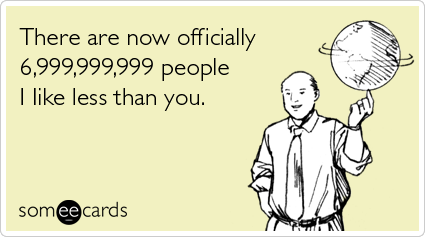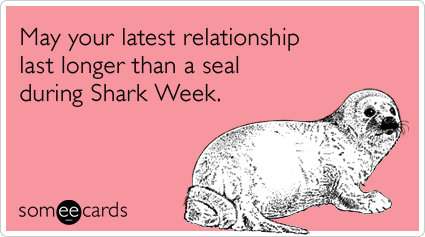Ecards Funny Love Definition
Source(Google.com.pk)
The definition of love offered to this point hasn’t specified one issue that is extremely important for practical reasons. How near to exact equality must the empathy of each partner for the other must be to qualify as love? All that has been said so far is that the amount should average out, over the long term, to near equality. But how near?
Exact equality of empathy between partners might exist in a few moments, but even there it would be rare. Usually one partner is more empathic than the other, in most of these moments, and over the long haul as well. In terms of my definition, does this mean that the more empathic partner loves more? Yes, the definition requires that. But it doesn’t eliminate the possibility of other kinds of equality in the relationship.
One possibility involves what might call secondary attunement. If the less empathic partner becomes aware that he is understood better by his partner than he understands her, he can compensate in other ways. For example, by listening longer to her than she does to him. Direct attunement is important in a relationship, but it is by no means the whole story, just as neither attachment and attraction are not the whole story either.
Discussion
Before ending this chapter, a few examples of various types of “love” will be offered to help flesh out the abstract ideas discussed above. Further examples will be offered in the chapters that follow. One example is the feeling of a mother for her new born infant. Is this feeling genuine love in the sense it is being defined here?
Granting that strong attachment between infant and parent begins at birth, the newborn infant cannot return the love of the parent because it is unable to become cognitively and emotionally attuned to the parent. The parent and other caretakers have to teach the infant how. Until the infant is capable of at least a modicum of sharing awareness with the mother, the feeling between them is not mutual love, but strong mutual attachment.
Very early in the infant’s life, however, the caretaker can learn to understand aspects of the infant’s experience, by accurately interpreting body language and cries (Stern 1977). Perhaps during the first weeks, the caretaker is able to experience one-way non-erotic love toward the infant.
The beginnings of mutual attunement seem to occur long before the development of language. Tronic et al (1982) have documented the exchange of smiles between infant and caretaker after only several months. Quite properly, according to the definition of love offered here, they refer to this process as “falling in love.” From the moment of birth, the infant and the mother are intensely attached. Exchanging of mutual glances and smiles begins the other component of non-erotic mutual love, attunement.
As indicated in Chapter 2, the process of teaching the baby cognitive attunement has been described by Bruner (1983). He shows how the parent, in seeking only to teach the child names of objects, also, inadvertently teaches attunement. The child sees that the parent is looking at the object and referring to it, so the child understands that the object is not only in its own mind, its also in the mom’s mind. Completing this process takes many years. Until this happens, the child is unable to take the role of the parent to the point that it becomes interdependent, rather than dependent.
Another similar combination, but between adults, is unrequited romantic love. This kind of affect is one-way romantic love. Perhaps the love of the Helen Hunt character toward the Nicholson character in As Good as it Gets, already mentioned above, is of this type. She is evidently attracted and attached to him, and is able to share his point of view. But since he is unable to do the latter, her love for him is not returned. Like an infant, he cannot partake of and value her point of view as much as his own. The affect he holds for her might be called obsessive desire. He is apparently attached and attracted to her, but tends toward self-focus, rather than balance between self and other. This cell also characterizes most cases of intense jealousy, which is also a psuedo-love.
A further combination that psuedo-love can be visualized in terms of the relationship between Kathy and Heathcliff, already mentioned above. Judging from the portrayal of them in the novel, they are obsessively and erotically engulfed with each other. This idea of requited “love” can also be found in many other novels and in the lyrics of popular songs. Similarly, one-way obsessive, erotic infatuation is often called love in novels and popular songs.
This chapter has suggested that the mindlessly broad definition of love in modern societies is a defense against feeling the painful emotions generated in the emotional/relational world. In particular, the notion that love is sacred, and/or indescribable can function to defend ourselves against the pain of loss, separation, or alienation.
Perhaps any kind of relationship that contains attachment, attunement, or attraction to any degree, no matter how much hostility or withdrawal are involved, is seen in an alienated society as preferable to no relationship at all. But this chapter provides a definition of love that is narrow and precise, one that might help discover the emotions disguised by vernacular usage, and the kinds of dysfunctional relationships that are hidden under the many meanings of love. The next chapter, on the portrayal of love in popular songs, provides examples of how the broad definition is played out in mass discourse.
Exact equality of empathy between partners might exist in a few moments, but even there it would be rare. Usually one partner is more empathic than the other, in most of these moments, and over the long haul as well. In terms of my definition, does this mean that the more empathic partner loves more? Yes, the definition requires that. But it doesn’t eliminate the possibility of other kinds of equality in the relationship.
One possibility involves what might call secondary attunement. If the less empathic partner becomes aware that he is understood better by his partner than he understands her, he can compensate in other ways. For example, by listening longer to her than she does to him. Direct attunement is important in a relationship, but it is by no means the whole story, just as neither attachment and attraction are not the whole story either.
Discussion
Before ending this chapter, a few examples of various types of “love” will be offered to help flesh out the abstract ideas discussed above. Further examples will be offered in the chapters that follow. One example is the feeling of a mother for her new born infant. Is this feeling genuine love in the sense it is being defined here?
Granting that strong attachment between infant and parent begins at birth, the newborn infant cannot return the love of the parent because it is unable to become cognitively and emotionally attuned to the parent. The parent and other caretakers have to teach the infant how. Until the infant is capable of at least a modicum of sharing awareness with the mother, the feeling between them is not mutual love, but strong mutual attachment.
Very early in the infant’s life, however, the caretaker can learn to understand aspects of the infant’s experience, by accurately interpreting body language and cries (Stern 1977). Perhaps during the first weeks, the caretaker is able to experience one-way non-erotic love toward the infant.
The beginnings of mutual attunement seem to occur long before the development of language. Tronic et al (1982) have documented the exchange of smiles between infant and caretaker after only several months. Quite properly, according to the definition of love offered here, they refer to this process as “falling in love.” From the moment of birth, the infant and the mother are intensely attached. Exchanging of mutual glances and smiles begins the other component of non-erotic mutual love, attunement.
As indicated in Chapter 2, the process of teaching the baby cognitive attunement has been described by Bruner (1983). He shows how the parent, in seeking only to teach the child names of objects, also, inadvertently teaches attunement. The child sees that the parent is looking at the object and referring to it, so the child understands that the object is not only in its own mind, its also in the mom’s mind. Completing this process takes many years. Until this happens, the child is unable to take the role of the parent to the point that it becomes interdependent, rather than dependent.
Another similar combination, but between adults, is unrequited romantic love. This kind of affect is one-way romantic love. Perhaps the love of the Helen Hunt character toward the Nicholson character in As Good as it Gets, already mentioned above, is of this type. She is evidently attracted and attached to him, and is able to share his point of view. But since he is unable to do the latter, her love for him is not returned. Like an infant, he cannot partake of and value her point of view as much as his own. The affect he holds for her might be called obsessive desire. He is apparently attached and attracted to her, but tends toward self-focus, rather than balance between self and other. This cell also characterizes most cases of intense jealousy, which is also a psuedo-love.
A further combination that psuedo-love can be visualized in terms of the relationship between Kathy and Heathcliff, already mentioned above. Judging from the portrayal of them in the novel, they are obsessively and erotically engulfed with each other. This idea of requited “love” can also be found in many other novels and in the lyrics of popular songs. Similarly, one-way obsessive, erotic infatuation is often called love in novels and popular songs.
This chapter has suggested that the mindlessly broad definition of love in modern societies is a defense against feeling the painful emotions generated in the emotional/relational world. In particular, the notion that love is sacred, and/or indescribable can function to defend ourselves against the pain of loss, separation, or alienation.
Perhaps any kind of relationship that contains attachment, attunement, or attraction to any degree, no matter how much hostility or withdrawal are involved, is seen in an alienated society as preferable to no relationship at all. But this chapter provides a definition of love that is narrow and precise, one that might help discover the emotions disguised by vernacular usage, and the kinds of dysfunctional relationships that are hidden under the many meanings of love. The next chapter, on the portrayal of love in popular songs, provides examples of how the broad definition is played out in mass discourse.
Ecards Funny Love Photos Pictures Pics Images 2013

Ecards Funny Love Photos Pictures Pics Images 2013

Ecards Funny Love Photos Pictures Pics Images 2013

Ecards Funny Love Photos Pictures Pics Images 2013

Ecards Funny Love Photos Pictures Pics Images 2013

Ecards Funny Love Photos Pictures Pics Images 2013

Ecards Funny Love Photos Pictures Pics Images 2013

Ecards Funny Love Photos Pictures Pics Images 2013

Ecards Funny Love Photos Pictures Pics Images 2013

Ecards Funny Love Photos Pictures Pics Images 2013

No comments:
Post a Comment